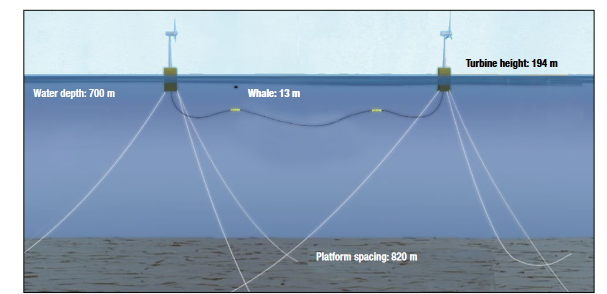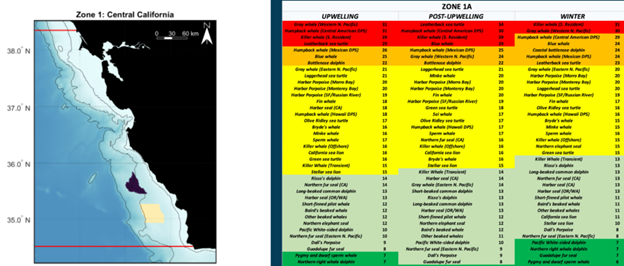Breadcrumb
- California Offshore Winds
- Whales and Marine Mammals
Whales and Marine Mammals
The areas off the California Coast where Wind Energy Areas are located are known habitat for for whales, dolphins, elephant seals, and other marine mammals. The Area is outside of biologically important feeding areas for migratory whale species. [1]
- What Whales and Marine Mammals are Located Off the California Coast
There are over 35 marine mammals that can be found off the California Coast during different seasons and in conjunction with upwelling events. Seven species of baleen whales are known to occur off California. Toothed whales known to occur offshore California include sperm whales (three species), orca (also known as “killer whales” from three morphologically distinct groups), beaked whales (15 species that are difficult to distinguish at sea), dolphins (19 species), and porpoises (two species). Pinnipeds include the eared seals (otariids) and the earless or true seals (phocids). Southern sea otters (Enhydra lutris nereis, mustelids) inhabit a limited portion of the central coast shoreline from Pigeon Point to Gaviota State Beach.
Several of these species are listed as endangered under the Endangered Species Act including the Blue Whale, Fin Whale, and Gray Whale (Western N. Pacific), and Humpback Whale (Central American population). Other species are listed as protected under the Marine Mammal Protection Act. NOAA listed West Coast Gray Whale between December 2018-November 2023 as subject to an unusual mortality event due to the death of 347 individuals in U.S. waters related to changes in the whale’s Arctic and Subarctic feeding areas that led to malnutrition and increased mortality. [2]
Researchers have calculated moderate, high and “highest” vulnerability scores for a series of species located off the California Coast on the basis of population factors, species habitat, physical interactions (e.g. strikes, entanglements), and other potential human stressors. See the table at end of this fact sheet. [3] Several species with high vulnerability scores include specific populations of grey whales, killer whales, humpback whales, and blue whales. [3] These findings do not indicate anything about the susceptibility of whales to specific floating offshore wind developments impacts described below.
- What are potential impacts on marine mammals from floating offshore wind?
Possible stressors for marine mammals with activities associated with wind farms include habitat changes and vessel collisions with construction boats or operation and maintenance vessels.
There is a possibility that wind infrastructure will attract marine biomass. It is unclear whether marine mammals will seek out floating offshore wind sites to forage if artificial reefs form on floating offshore wind infrastructure or if turbine platforms operate like fish aggregating devices. [4]
While direct entanglement of whales in offshore wind infrastructure is unlikely. The mooring lines are heavy and taut and the electrical lines will also not pose an entanglement threat because of their large diameter which prevents them from looping. The spatial scale of offshore wind infrastructure and marine life further reduces the possibility of direct entanglement as illustrated in the image below. Secondary entanglement is possible if fishing gear (particularly abandoned, lost, or derelict gear) or other large garbage becomes entangled around floating offshore wind moorings and cables. Between 1982 and 2017, 511 large whales of the Western US coast experienced entanglement with the majority of these being humpback whales and grey whales. [5] Secondary entanglement is not just a threat for whales but also fish, turtles, seals, and diving seabirds.
Image
Image from an animation of a 13m whale transiting a floating offshore wind farm. For full animation, please visit https://www.pnnl.gov/news-media/exploring-encounters-between-humpback-and-floating-wind-farms
- What are potential mitigation measures to address impacts?
Federal and state agencies have not designated mitigation measures for U.S. floating offshore wind projects yet in federal waters for construction and operation. There are mitigation measures to protect species during geophysical surveys. [6]
There have been required marine mammal mitigation for East Coast offshore wind projects and there have been provisions associated with permits issued for low-energy geophysical surveys off the coast of Vandenberg Space Force base in Santa Barbara County.
A number of conditions have already been imposed on the site assessment work for Morro Bay as part of the environmental assessment. [6]
In supporting upcoming lease characterization studies, metocean buoy installations (meteorological/oceanographic buoys that will be deployed to measure wind and current), and other surveys, vessels must not travel at speeds of more than 10 knots. To minimize any potential impact from radio energy, for any vessels operating CHIRP (compressed high-intensity radar pulse) sub-bottom profilers to map the seabed floor, the area where surveying may be done must be visually cleared of any endangered species act (ESA) listed species for 30 minutes before a sound source is turned on. Any detection of an ESA-listed species will result in a shutdown of survey activities. [6] The visual clearance zone will be monitored by an approved third-party protected species observer. If surveying is being done by autonomous surface vessels, a protected species observers must be able to monitor real-time output from cameras attached to the autonomous vessel. [6]
Other mitigation includes vessel strike avoidance including having a protected species observer onboard (who may be a trained crew member as long as looking for species is the only responsibility of the crew member) ensuring that vessels slow down or change course. A 500-meter distance is required from all ESA-listed marine mammal species and 100 meters from any sea turtle. [5] All vessel crew members must be able to identify protected marine species. If a large whale is spotted within 500 meters of the forward path of the vessel, the operator must steer away until a 500-meter separation distance has been established. If the whale is within 200 meter, the operator must reduce speed and shift the engine to neutral until the whale has moved outside of the vessel's path and beyond 500 meters. [6] If a sea otter or sea turtle is spotted, the vessel operator must slow down to 4 knots and steer away. Protected species observers must provide reports of compliance with the protection measures.
The wind developer must submit monitoring reports to BOEM, the National Marine Fisheries Service, and the California Coastal Commission within 3 months of completing all yearly survey activities.
For any equipment that requires mooring, the developers are expected to take steps to reduce entanglement risks by using short line lengths and other practices to avoid looping, wrapping, or entrapping protected species.
- Why are there whale strandings on the East Coast?
In 2017, NOAA announced the start of an unusual mortality event for humpback whales that have been found stranded along the Atlantic coast from Maine to Florida. For Atlantic humpback whales whose cause of death can be determined by necropsy (some whales are too decomposed for research purposes), 40% were determined to be killed by vessel strikes (as determined from broken bones) or entanglement in fishing gear. Other sources of death included parasite-driven organ damage.[7] Most whale strandings are not caused by anthropogenic sounds.[8]
- References
[1] Morro Bay Leasing Area Environmental Impact Assessment, Appendix A, Area ID for Commercial Wind Energy Leasing, https://www.boem.gov/sites/default/files/documents/renewable-energy/state-activities/2202_AppA_MB_AreaIDMemo_Signed.pdf
[2] 2019-2023 Eastern North Pacific Gray Whale Unusual Mortality Event, https://www.fisheries.noaa.gov/national/marine-life-distress/2019-2023-eastern-north-pacific-gray-whale-ume-closed
[3] Brandon Southall, New Risk Assessment Methods to Understand Vulnerability of Marine Mammals and Sea Turtles to Offshore Sustainaof ble Energy Development (2023) https://documents.coastal.ca.gov/assets/upcoming-projects/offshore-wind/Th4/Th4-Southall.pdf
[4] Fernandez-Betelu, O., Graham, I.M., and Thompson, P.M. (2022): Reef effect of offshore structures on the occurrence and foraging activity of harbour porpoises. Frontiers in Marine Science 9.
[5] Saez, L., Lawson, D., and DeAngelis, M. (2021): Large whale entanglements off the U.S. West Coast, from 1982-2017. NMFS-OPR-63A. National Oceanic and Atmospheric Association
[6] Morro Bay Leasing Area Environmental Impact Assessment, Appendix D. Typical Environmental Protection Mitigation measures and Best Management Practices, https://www.boem.gov/sites/default/files/documents/renewable-energy/state-activities/2022-App-D-Typical-BMPs.pdf
[7] NOAA,Office of Protected Resources, https://www.fisheries.noaa.gov/national/marine-life-distress/2016-2024-humpback-whale-unusual-mortality-event-along-atlantic-coast#causes-of-the-humpback-whale-ume
[8] University of Rhode Island, Discovery of Sound in Sea, https://dosits.org/facts-and-myths/
Image
Images from Dr. Brandon Southall’s presentation to the California Coastal on risk assessment methods to understand vulnerability of marine mammals and sea turtles https://www.coastal.ca.gov/upcoming-projects/offshore-wind/